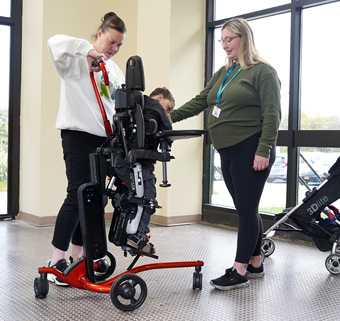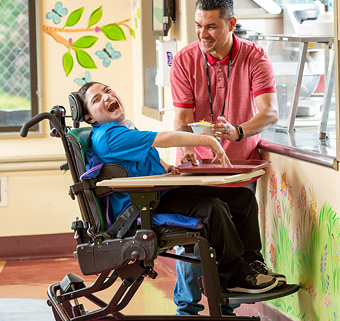Homing in on Segmental Trunk Support for Better Control
| September 2018
While many in the therapy community have not heard (yet) about SATCo, it’s a valuable new assessment that looks at trunk control. SATCo stands for Segmental Assessment of Trunk Control and it is a specific method of determining the level at which an individual loses postural control. We speak of “segmental assessment” because during evaluation we progressively change the level of trunk support at seven distinct levels.
SATCo begins by providing a high level of support at the shoulder girdle, which assesses head control. Then, support is provided at the axillae to assess upper thoracic control. Support is systematically lowered to the level of the inferior scapula to assess mid thoracic control, the lower ribs (lower thoracic control), below ribs (upper lumbar control), pelvis (lower lumbar control), and finally, no support, which of course measures full trunk control. This method offers a level by level assessment and the information can be used to create a treatment approach for practicing and gaining trunk control. Throughout the assessment, achieving and maintaining a neutral pelvis position is paramount for success; it is done by using a strapping system when the child is positioned on a bench to “lock” their pelvis in place.
By assessing a child using SATCo rather than looking at the trunk as a single unit, we are able to determine the specific level at which the child loses control. Then, using this information, we target positioning and intervention strategies at the specific level at which the child is functioning.
In Prince George’s County Public Schools in Maryland, we had the opportunity to receive training in SATCo and we’ve begun to incorporate this method with our kids. For example, we incorporate this concept of segmental trunk control into classroom positioning by providing support at the appropriate level to support and improve classroom participation. We provide segmental support to students in both sitting and standing, and we find that the adjustability of Rifton equipment makes this possible.
Of course, segmental support looks different for each student. Essentially, support at the appropriate segmental level may allow the student to do a number of things. They could hold their head up for longer periods of time; have better hand function, better speech production or improved visual skills.
Take, for example, our student Sydney. She is at the SATCo level of “Head.” She can hold her head in neutral for short periods and we are working to increase that. We also want her to have better hand function to use classroom tools and for more independent eating.
To get Sydney’s pelvis and trunk in neutral alignment we have added a small wedge to her Rifton Activity Chair seat.We can also adjust the tilt of her Activity Chair to assist further in getting the alignment we want. The seatbelt holds her pelvis into position and the trunk laterals prevent her from leaning to either side. The chest strap keeps her secure with her shoulders back and the headrest gives her extra support for her to work on getting the chin tuck she is working on.
We have used adaptations at times to achieve the positioning we want. We’ve sometimes used additional straps, foam or even abdominal binders to get the results we need. Pool noodles are cheap and easy to use for extra support.
 On the picture, you can see that the tray is raised to provide support up to the level of the axilla so Sydney can isolate her work on head control. The armrest height is easily adjustable so we can change the height of the tray for some activities. For eating she needs the tray lower so she can work on scooping her food.
On the picture, you can see that the tray is raised to provide support up to the level of the axilla so Sydney can isolate her work on head control. The armrest height is easily adjustable so we can change the height of the tray for some activities. For eating she needs the tray lower so she can work on scooping her food.
We have found that segmental support works well in the classroom setting. The classroom staff has learned to position their students in the adapted equipment with segmental trunk support so the students can work on head and trunk control throughout the school day. As our teachers and paraprofessionals see their student’s improved participation, they are excited about the potential for segmental support as well.
There is published research on this method. In 2010, Butler et al established that the SATCo is a reliable and valid measure allowing clinicians greater specificity in assessing trunk control. In 2018, Hansen et al found that the SATCo is a clinically applicable assessment tool: relative reliability is excellent and absolute agreement is good.
What is exciting about this evaluation tool is that it assesses more than one aspect of postural control: 1. static (or steady state) control 2. active (or anticipatory) control and 3. reactive control (maintaining or regaining trunk control following a threat to balance, produced by a brisk nudge).
The 2016 study by Santamaria et al looked at the effect of segmental postural control on posture and reaching. Outcomes showed that children with cerebral palsy may achieve reaching tasks with better success when external support is provided and aligned with their intrinsic level of trunk control.
Saavedra et al 2010, Saavedra & Woollacott 2015, and da Costa et al 2017 are all studies with interesting findings on head control with varying support provided. The free full text links are available below.
Please check out the bibliography with abstracts and full text links below. And you may certainly reach out to me to learn more.
Bibliography
Argetsinger LC, Trimble SA, Roberts MT, Thompson JE, Ugiliweneza B, Behrman AL.(2018) Sensitivity to change and responsiveness of the Segmental Assessment of Trunk Control (SATCo) in children with spinal cord injury. Dev Neurorehabil. 22:1-12. doi: 10.1080/17518423.2018.1475429. [Epub ahead of print] Abstract https://www.tandfonline.com/doi/full/10.1080/17518423.2018.1475429
Butler PB, Saavedra S, Sofranac M, Jarvis SE, Woollacott MH. (2010) Refinement, reliability, and validity of the segmental assessment of trunk control. Pediatr Phys Ther 22(3):246-57. Free Full Text https://www.ncbi.nlm.nih.gov/pmc/articles/PMC2927393/
Curtis DJ, Butler P, Saavedra S, Bencke J, Kallemose T, Sonne-Holm S, Woollacott M. (2015) The central role of trunk control in the gross motor function of children with cerebral palsy: a retrospective cross-sectional study. (2015) Dev Med Child Neurol. 2015 Apr;57(4):351-7. Free Full Text https://onlinelibrary.wiley.com/doi/full/10.1111/dmcn.12641
Curtis DJ, Woollacott M, Bencke J, Lauridsen HB, Saavedra S, Bandholm T, Sonne-Holm S. (2018) The functional effect of segmental trunk and head control training in moderate-to-severe cerebral palsy: A randomized controlled trial. Dev Neurorehabil. 21(2):91-100. Abstract: https://www.tandfonline.com/doi/full/10.1080/17518423.2016.1265603
da Costa CS, Saavedra SL, Rocha NA, Woollacott MH. (2017) Effect of Biomechanical Constraints on Neural Control of Head Stability in Children with Moderate to Severe Cerebral Palsy. Phys Ther. 2017;97(3):374-85. Free Full Text https://academic.oup.com/ptj/article/97/3/374/2998981
Goodworth AD, Wu YH, Felmlee D, Dunklebarger E, Saavedra S. (2017) A Trunk Support System to Identify Posture Control Mechanisms in Populations Lacking Independent Sitting. IEEE Trans Neural Syst Rehabil Eng. 25(1):22-30. Free Full Text https://www.ncbi.nlm.nih.gov/pmc/articles/PMC5035563/
Hansen L, Erhardsen KT, Bencke J, Magnusson SP, Curtis DJ. (2018) The Reliability of the Segmental Assessment of Trunk Control (SATCo) in Children with Cerebral Palsy. Phys Occup Ther Pediatr. 38(3):291-304. Abstract https://www.tandfonline.com/doi/full/10.1080/01942638.2017.1337662
Rachwani J, Santamaria V, Saavedra SL, Woollacott MH. (2015) The development of trunk control and its relation to reaching in infancy: a longitudinal study. Front Hum Neurosci. Feb 24;9:94. Free Full Text https://www.ncbi.nlm.nih.gov/pmc/articles/PMC4338766/
Saavedra S, Joshi A, Woollacott M, van Donkelaar P. (2009) Eye hand coordination in children with cerebral palsy. Exp Brain Res. 192(2):155-65. Free Full Text https://www.ncbi.nlm.nih.gov/pmc/articles/PMC2800126/
Saavedra SL, Woollacott MH. (2015) Segmental Contributions to Trunk Control in Children With Moderate-to-Severe Cerebral Palsy. Arch Phys Med Rehabil 96(6):1088-97. Free Full Text https://www.ncbi.nlm.nih.gov/pmc/articles/PMC4457569/
Saavedra S, Woollacott M, van Donkelaar P. (2010) Head stability during quiet sitting in children with cerebral palsy: effect of vision and trunk support. Exp Brain Res. 2010 Feb;201(1):13-23. Full Free Text https://www.ncbi.nlm.nih.gov/pmc/articles/PMC2821460/
Saavedra SL, Teulier C, Smith BA, Kim B, Beutler BD, Martin BJ, Ulrich BD. (2012) Vibration-induced motor responses of infants with and without myelomeningocele. Phys Ther. 92(4):537-50. Full Free Text https://www.ncbi.nlm.nih.gov/pmc/articles/PMC3317481/
Santamaria V, Rachwani J, Saavedra S, Woollacott M. (2016) Effect of Segmental Trunk Support on Posture and Reaching in Children With Cerebral Palsy. Pediatr Phys Ther. 28(3):285-93. Free Full Text https://www.ncbi.nlm.nih.gov/pmc/articles/PMC4922488/




